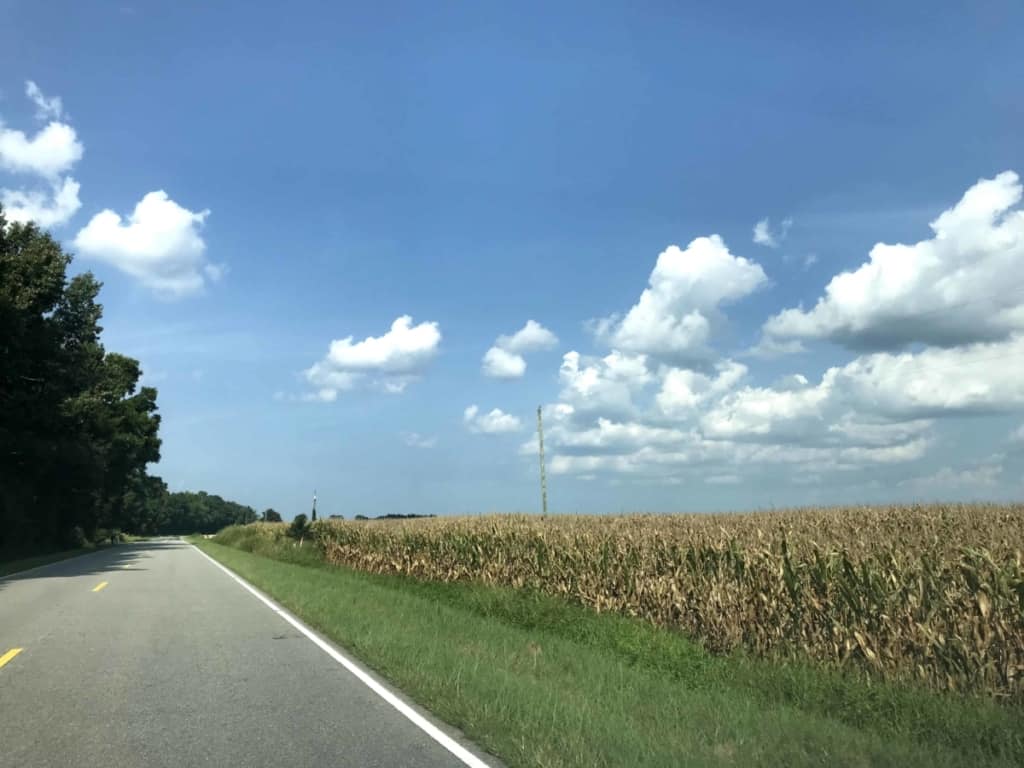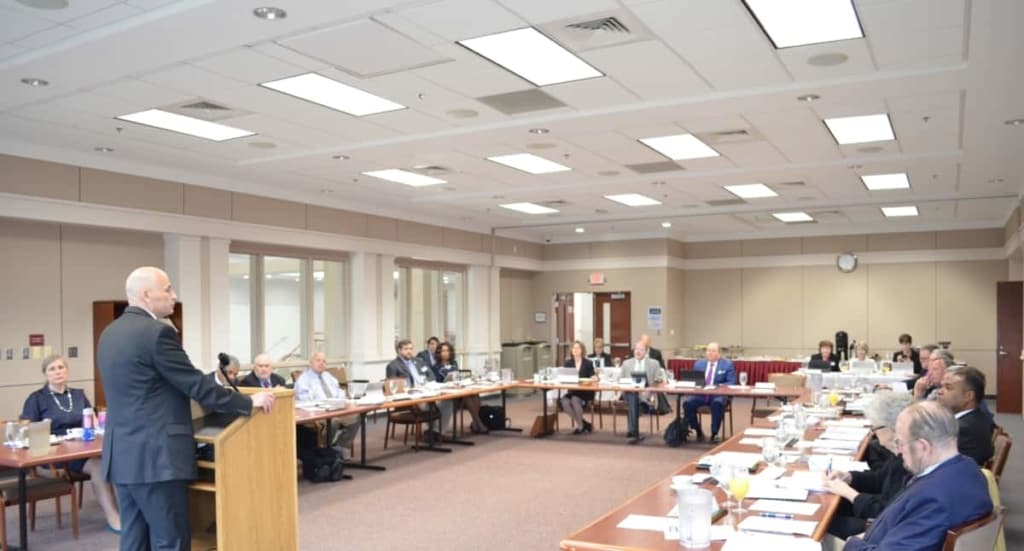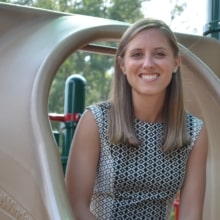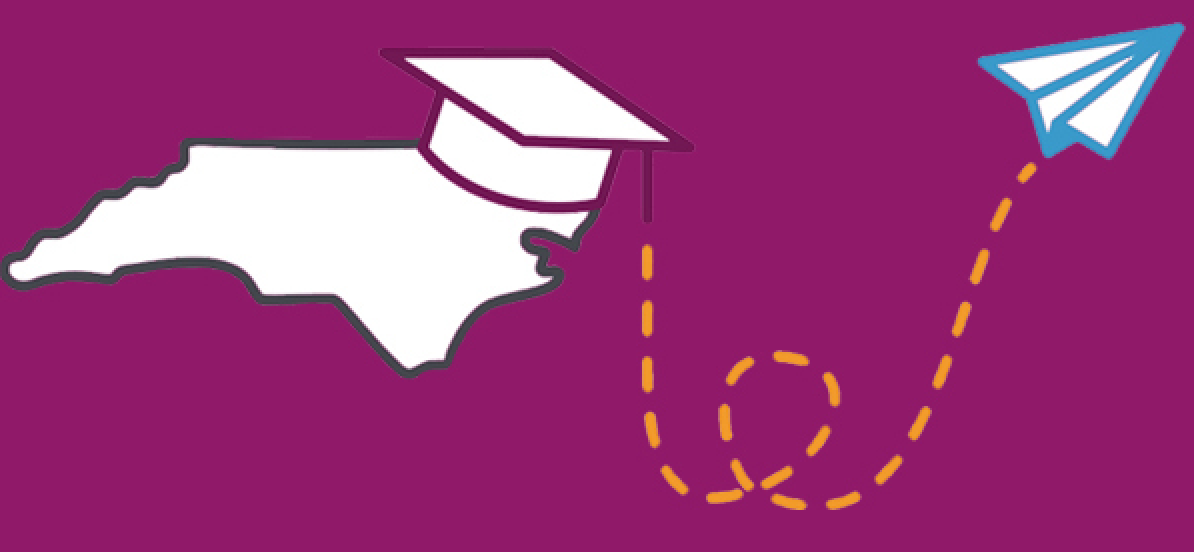
“Community colleges might best be described as our community’s college.”
Mebane Rash, the CEO of EdNC.org, said this one morning as we planned the expansion of our coverage into postsecondary education and workforce development.
The data showed this to be true: the system includes 58 colleges spread across the state serving more than 700,000 North Carolinians.
Students attend community college for many reasons. As we’ve traveled over the last year, we’ve met students who aim to complete a two-year degree, others who intend to transfer to a four-year institution, and plenty of folks who are aiming to obtain a high-quality credential.
We met Amanda Vick who obtained a GED before focusing on raising her children, and then decided to go back to attend Martin Community College for a two-year degree because of her children.
We met many other students and shared their stories through our exploration of the North Carolina education pipeline.
These stories guide our reporting and our work. We know the students, staff, and community members that we’ve met have real information needs.
They want to know: How are colleges funded and why? Are transfer articulation agreements working for all students? How do we boost attainment across North Carolina to hit the 2 million goal set by myFutureNC? And why does the attainment goal matter?
We have worked to answer critical questions this year — and we know we have a lot more to answer on behalf of our students, our colleges, and our state.
What are your questions? What stories should we tell? Let us know below.
We are grateful to all of the 58 community colleges for opening up their doors to us for the last year — as they have for so many North Carolinians over the decades.

In May 2018, EducationNC landed a two-year, $1 million investment from the John M. Belk Endowment, allowing us to expand our coverage to the whole education continuum from birth to career. To kick off this expansion, we hit the road in the last week of August to build relationships, surface issues, identify sources, and raise awareness of the colleges. Splitting up into teams of one or two, our staff of 11 traveled more than 6,000 miles across the state to visit all 58 community colleges in one week — an effort we called “the blitz.”
During each of the visits, college administration, faculty, staff, students, and local business owners provided tours of their campuses and offered insight into the unique opportunities and challenges they face. Most of the visits lasted at least half a day, with many lasting longer; the longest visit lasted closer to two days.
Throughout the week, we built a robust architecture of participation to engage our new audience. We published perspectives from statewide leaders, including John M. Belk Endowment Board Chair MC Belk Pilon and North Carolina Community College System (NCCCS) President Peter Hans. We published articles about our visits from the week and continued to publish those for the next two months as we came home, reflected on what we had learned, and shared it with our audiences, both old and new. We engaged on social media, live tweeting our visits using the hashtag #Awake58. And we sent out the first Awake58, a weekly newsletter that delivers essential news and information about our community colleges and the future of the state.
Better News highlighted the blitz as a strategy to build trust and get to know a new audience, and in March, EducationNC won the Duke University Green-Rossiter Award for Distinguished Newspaper Work in Higher Education at the North Carolina Press Association awards for the blitz. The judges described it as “smart, ambitious, sweeping, and eye-opening; no doubt readers learned a lot about the 58 community colleges in their midst.”
As we traveled the state, we asked questions, took notes, and took photos, but mostly we listened. When you have a community that has not been traditionally covered, reporters can be scary. People asked us, “What’s your angle, what’s your story?” We said, “Our story is your story. It is predicated on listening to you.”
After each visit, we entered notes in a team Google Document on challenges, opportunities, and areas for follow-up. Throughout the year, we went back to that document as we mapped out our coverage. We shared many of the stories we heard, and we look forward to sharing more over the next year.

The week that our team fanned out across North Carolina for the blitz coincided with the first edition of Awake58.
We knew all along that we wanted to have a weekly touch point with community college faculty and staff, students, and all others who are invested in postsecondary education and workforce development in our state. And we knew that email was a great way to do just that.
Each week, we spotlight our own content, curate the most important pieces on postsecondary from around the country, and lift up important happenings around North Carolina.
More importantly, we aspire for Awake58 to be a tool for conversation. Every response you send goes directly to our inbox. You have let us know how we are doing — and when we’ve missed something important.
In response to one issue of Awake58, you let us know how much the Residency Determination Service has impacted your campuses. You shared stories of students who had struggled through the process and told us about the impact on our own staff. Your early reports gave us the context we needed to go figure out the full story.
In response to a call to understand the issues you find most important, you let us know just how long it has been since you’ve seen significant pay raises for faculty and staff. You shared stories of numerous faculty working two jobs just to make ends meet. We’re going to stick with this story in the years ahead.
You’ve also shared bright spots that we’ve featured to illustrate solutions across our state.
Leadership matters. This is one of the key lessons for all of us at EdNC.org. We saw it in the K-12 sector — and we see it in the higher education space.
We began visiting campuses in November of 2017. Since that time, 12 colleges have inaugurated new presidents. More recently, three colleges (Nash, Roanoke-Chowan, and Guilford Tech) have seen presidential appointments approved by their boards of trustees. Three more colleges (Gaston College, A-B Tech, and Martin Community College) have search processes open currently.
This turnover is part of a larger trend across the entire North Carolina Community College System. We’ve met with faculty members who ask how they might become presidents one day. We’ve heard from staff and board of trustee members who wonder how their colleges can better plan for transitions. And we’ve seen how outgoing presidents on-board their successors.
You asked us to share lessons learned from both retiring and incoming presidents. We have done so — and we’re going to keep on sharing those stories in the years ahead.

Throughout the blitz, we heard a recurring theme: community colleges are North Carolina’s best-kept secrets. As open-door institutions, they serve whoever walks through their doors. The 58 colleges are spread across the state so that no North Carolinian lives more than a 30-minute drive from the chance to get an education. And, compared to the cost of a four-year institution these days, community college tuition is especially affordable.
The open-door philosophy is crucial to the identity of our community colleges and can be felt as soon as you set foot on campus. But it means they deal with a host of challenges and opportunities not found at four-year institutions. As we learned about the world of community colleges, including the unique language required to understand that world, we knew we needed to build awareness around these challenges and opportunities and make North Carolina’s best-kept secret not so secret anymore.
In addition to the articles from the blitz featuring different courses, programs, and leaders on campus, we took a deeper look at several of the challenges and opportunities that we kept hearing about during our visits: the Residency Determination Service (RDS), the funding formula tied to previous years’ enrollment, the growth of early college and Career and College Promise students, and the opportunities to collaborate with local business and industry.
Residency Determination Service
During the blitz, we heard story after story about the Residency Determination Service, or RDS. RDS is the online application students have to fill out to get in-state tuition for any public higher education institution in North Carolina. Colleges told us their students were having trouble completing the application, and they believed it was hurting their enrollment. After the State Board of Community Colleges discussed the issues at their meeting in October, we knew we needed to better understand the process and share the stories we heard on the blitz.
EdNC.org reporters and researchers collaborated to produce a five-part series exploring the purpose of RDS, the implications for community college students, and the NCCCS’s proposed legislative solution.
https://www.ednc.org/2018/12/11/residency-for-community-colleges-seeking-a-better-life/
We stayed with the story as RDS officials and the community college system worked together to determine a solution. In July, Gov. Roy Cooper signed a bill amending the statute to allow prospective students to use graduation from high school in North Carolina as evidence of residency during the RDS process. Colleges hope the bill will make it easier for students to complete the RDS application and receive in-state tuition.
https://www.ednc.org/2019/07/25/community-college-system-hopes-new-law-will-ease-recent-application-issues/
Funding and enrollment
As we traveled across the state and heard terms like “con ed” and “FTE” in response to questions about enrollment, we knew we needed to do a deep dive on how community colleges measure enrollment — both to educate ourselves and to inform our wider audience as we began to report on these issues. So, we did an EdExplainer on community college enrollment and looked at how enrollment challenges vary across urban and rural environments.
https://www.ednc.org/2019/03/05/edexplainer-community-college-enrollment/
One of the biggest challenges we heard about on the road was the fact that the current funding formula is tied to enrollment in previous years rather than the current year, as is the case in K-12. When the economy is growing and enrollment falls as people choose work over school, this is not as much of an issue. But when enrollment spikes during economic downturns, colleges face a funding crunch as enrollment grows without the funding to support it.
To better explain how the state funds community colleges, we teamed up with Jennifer Haygood from the System office. Watch the video below for a brief overview of the funding formula.
In a pair of follow-up pieces, John Quinterno explored challenges with the current funding formula, including funding adequacy and stability, performance funding, and a changing student body. Quinterno pointed out that of every $100 appropriated for public education in fiscal year 2015-16, just $9 went to the state’s community colleges. At the same time, the share of low-income and part-time students at community colleges is growing, putting a greater strain on colleges’ already limited resources. We will continue to explore these issues throughout this year.
https://www.ednc.org/2019/03/13/from-a-changing-student-body-to-fewer-state-dollars-the-challenges-of-funding-north-carolinas-community-colleges/
Early colleges
In January, we published a five-part series on North Carolina’s Cooperative Innovative High Schools (CIHS), the majority of which are early colleges. The series started with an overview of CIHS’s in North Carolina, including a look at their school performance grades and the legislation that created them in 2004.
https://www.ednc.org/2019/01/07/cooperative-innovative-high-schools-what-are-they-and-why-does-north-carolina-have-so-many/
In 2017-18, CIHS’s scored higher on state performance measures than public schools overall; 72% of CIHS’s received a school performance grade of A compared to only 6.5% of public schools statewide. So when the Senate released their budget with a provision to phase out the supplemental funding the state provides to CIHS’s, we needed to know why.
https://www.ednc.org/2019/06/14/why-why-why-why-are-cuts-to-early-colleges-on-the-table/
We stayed with the story as the ripple effects of the Senate budget provision became clear: the Carteret County Board of Education voted to close the Marine Science and Technology Early College High School (MaST) after seeing the Senate budget provision. The compromise budget that eventually passed the General Assembly did not include the provision cutting supplemental funding, and after parent complaints, the board agreed to keep the school open.
https://www.ednc.org/2019/08/05/how-legislative-tactics-almost-shut-down-an-early-college-high-school/

We have a lot of plans for the year ahead, but one common theme is that you all will help us determine the direction of our work. So we want to know — what questions do you have? What information do you need to do your job or jump start your education journey? We want to hear from you.
We are going to continue to travel the state to elevate your stories, illustrate solutions to our most pressing challenges, and educate folks on the issues that are impacting their lives.
You can expect more first-person perspectives from community college presidents, staff, and faculty. We want the state to hear from you — all of you.
We will continue to report on the North Carolina Community College State Board, the legislature, and the range of commissions that are working across our educational spectrum. It matters that we show up. Transparency, accountability, and sunlight come from our team being present.
We are going to track the progress of myFutureNC as they launch their own nonprofit and work to align the state towards their attainment goal of 2 million 24-45 year olds with a degree or high-quality credential by 2030.
We will explore college access this year. We have been conducting research on summer melt — and we will share those lessons soon. In the meantime, we encourage you to check out the NC Education Pipeline for more information. We are going to explore financial barriers to access, including FAFSA completion rates and the challenges undocumented students face in terms of tuition, access to scholarships, and more.
We will also look at completion — including how it’s measured and how North Carolina is doing.
We are going to do a deep dive on articulation agreements, explore dual enrollment programs and the future of early colleges, and look at other efforts designed to ease transitions for students.
Please let us know what important stories we’ve missed as we plan for the year ahead. Our reporting cannot happen in a vacuum. At our best, our reporting will answer your important questions so that we equip you to engage in the daily work of improving your community.
Editor’s note: The John M. Belk Endowment supports the work of EducationNC.
Weekly Insight Community Colleges


